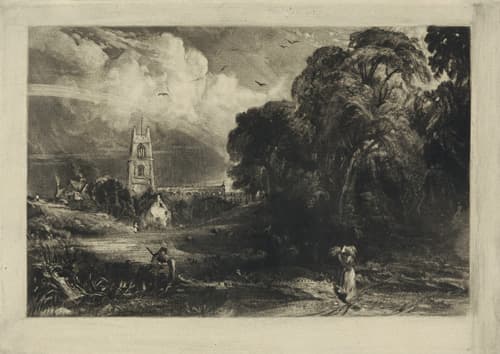
Inscribed
CHRISTUS PETRO OVIUM CURAM COMMITIT
John Chap. XXI – Raphael Sanctius Urbinas pinxit – John Constable delt
Biographies
John Constable was a landscape painter born at East Bergholt in Suffolk in 1776. He was, with Turner (q.v.) the major English landscape painter of the 19th century. Although he started exhibiting at the Royal Academy in 1802 it was not until 1819 that he was finally recognised by the Academy. In his own words the Suffolk countryside made him a painter and he was happiest at painting watermills and windy skies, a love he owes to his upbringing as the son of a miller. His success in France influenced the development of artistic movements such as the Barbizon School and Romantic artists such as Eugene Delacroix. He was the last great painter of the Dutch landscape tradition. A large collection of his works was donated to the V&A by his daughter and Christchurch Mansion in Ipswich Suffolk has the greatest number of his paintings outside London.
Sir Nicholas Dorigny (1658-1746) was a French printmaker considered as one of the most reputable engravers working in Rome in 1711, when he was persuaded to engrave Raphael’s Cartoons at Hampton Court by a group of English virtuosi including the banker Robert Child (1674-1721). He stayed in England for thirteen years, until 1724 to carry out this task, and then returned to France. He was knighted for that.
Statement
In 1795 Constable, then 19, was already showing a great deal of interest in drawing. In fact it started earlier. At Dedham Grammar School he had been seen drawing and sketching, even during the lessons which attracted comments from his teachers. In Dedham also lived Lady Beaumont, the widow of a miller long acquainted with the Constable family, being in the same trade. Lady Beaumont had a son, Sir George Beaumont, an amateur painter and patron of the arts, who divided his time between London and Great Dunmow, keeping his collection in London. It is very likely that he owned a set of the Dorigny engravings since these were prints which were at the core of any serious art historical collector. It is very likely that Sir George Beaumont loaned the prints in order to test Constable’s skill at drawing and expose him to the great masters. It was Constable’s mother’s ambition to send her son to London to further his artistic education, hopefully with the help of Sir George Beaumont.
At the time the series of the seven large cartoons executed by Raphael and intended for tapestries to hang in the Sistine Chapel was the centre of artistic attention and considered in England as ‘the most valuable set of portable Pictures in the world’. They had been brought from Italy to England by the Prince of Wales, later Charles I, and although they could only be seen by visitors at Hampton Court, Dorigny’s engravings had popularised them and made them more accessible.
This particular drawing by Constable is therefore an example of the artist’s work during his formative years. It shows the artist’s evident difficulties with the rudiments of drawing as one would expect from such a young man. Unfortunately Sir George Beaumont was not impressed at the time and simply gave the budding artist kind encouragement. It is only three years later that he introduced Constable to the Royal Academy School. Constable’s admiration for Raphael however never waned and in 1835, in his last lecture to the students of the RA, he still praised Raphael as one of the greatest painters which ever existed.
Iconography
The original painting which is the subject of the third plate out of the seven refers to two passages taken from the New Testament: Matthew 16:18-19 and John 21:15-17. The two scenes, which in the Bible occur separately, here have been combined to emphasize their importance as scriptural justifications of the authority of the Pope. Therefore on the one hand one can see Christ appearing to Peter and the rest of his disciples, giving Peter the keys of Heaven and on the other hand Christ gesturing towards a flock of sheep, telling Peter to feed them and look after them. This work is also known as The Handing-over of the Keys.The surviving tapestries are in the Vatican and the cartoons are at the V&A loaned from the Royal Collection
Bibliography
- From Gainsborough to Constable : the emergence of naturalism in British landscape painting 1750-1810, Gainsborough’s House Society,1991
- BROWNE, Clare and EVANS, Raphael: Cartoons and Tapestries for the Sistine Chapel, V&A, 2010
Credit
Timothy Clayton for his help with information about Sir George Beaumont ownership of Dorigny’s engravings
Evelyne Bell







